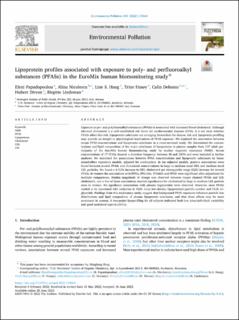| dc.contributor.author | Papadopoulou, Eleni Zoumpoulia | |
| dc.contributor.author | Nicolescu, Alina | |
| dc.contributor.author | Haug, Line Småstuen | |
| dc.contributor.author | Husøy, Trine | |
| dc.contributor.author | Delenau, Calin | |
| dc.contributor.author | Dirven, Hubert | |
| dc.contributor.author | Lindeman, Birgitte | |
| dc.date.accessioned | 2022-10-03T07:56:07Z | |
| dc.date.available | 2022-10-03T07:56:07Z | |
| dc.date.created | 2022-09-09T10:30:59Z | |
| dc.date.issued | 2022 | |
| dc.identifier.citation | Environmental Pollution. 2022, 308 1-12. | |
| dc.identifier.issn | 1566-0745 | |
| dc.identifier.uri | https://hdl.handle.net/11250/3023207 | |
| dc.description.abstract | Exposure to per- and polyfluoroalkyl substances (PFASs) is associated with increased blood cholesterol. Although elevated cholesterol is a well-established risk factor for cardiovascular diseases (CVD), it is not clear whether PFASs affect this risk. Lipoprotein subclasses are emerging biomarkers for disease risk and lipoprotein profiling may provide an insight to physiological implications of PFAS exposure. We explored the association between serum PFAS concentrations and lipoprotein subclasses in a cross-sectional study. We determined the concentrations and lipid composition of the major subclasses of lipoproteins in plasma samples from 127 adult participants of the EuroMix human biomonitoring study by nuclear magnetic resonance (NMR). Serum concentrations of 17 PFASs showed a detection frequency between 30 and 100% and were included in further analyses. We examined the associations between PFAS concentrations and lipoprotein subclasses by linear mixed-effect regression models, adjusted for confounders. In the adjusted models, positive associations were found between several PFASs and cholesterol concentrations in large to medium sized HDL and medium sized LDL particles. We found a 4–12% increase in HDL cholesterol per interquartile range (IQR) increase for several PFASs. In women the associations with PFNA, PFUnDA, PFDoDA and PFOS were significant after adjustment for multiple comparisons. Similar magnitude of change was observed between longer chained PFASs and LDL cholesterol, and a few of these associations reached significance for cholesterol in large to medium LDL particle sizes in women. No significant associations with plasma triglycerides were observed. However, most PFASs tended to be associated with reduction in VLDL (very low-density lipoproteins) particle number and VLDL triglyceride. Findings from this exploratory study, suggest that background PFAS exposures influence particle size distributions and lipid composition of plasma lipoprotein subclasses, and that these effects may be more prominent in women. A two-points lipoprofiling for all subjects indicated both low intra-individual variability and good analytical reproducibility. | |
| dc.description.abstract | Lipoprotein profiles associated with exposure to poly- and perfluoroalkyl substances (PFASs) in the EuroMix human biomonitoring study | |
| dc.language.iso | eng | |
| dc.title | Lipoprotein profiles associated with exposure to poly- and perfluoroalkyl substances (PFASs) in the EuroMix human biomonitoring study | |
| dc.title.alternative | Lipoprotein profiles associated with exposure to poly- and perfluoroalkyl substances (PFASs) in the EuroMix human biomonitoring study | |
| dc.type | Peer reviewed | |
| dc.type | Journal article | |
| dc.description.version | publishedVersion | |
| dc.source.pagenumber | 1-12 | |
| dc.source.volume | 308 | |
| dc.source.journal | Environmental Pollution | |
| dc.identifier.doi | 10.1016/j.envpol.2022.119664 | |
| dc.identifier.cristin | 2050213 | |
| dc.relation.project | EC/H2020/633172 | |
| cristin.ispublished | true | |
| cristin.fulltext | original | |
| cristin.qualitycode | 1 | |
